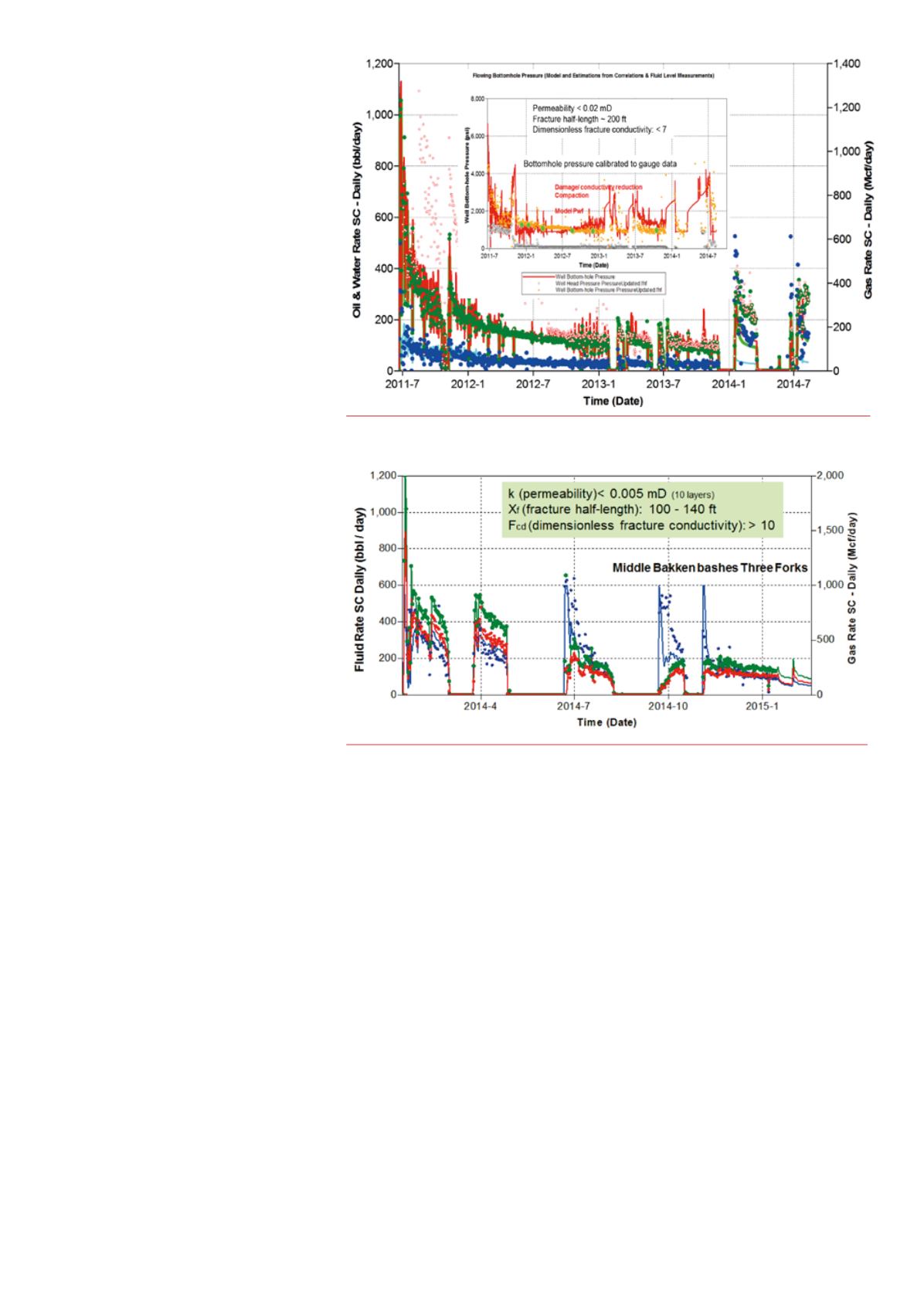
June
2016
Oilfield Technology
|
49
Fractureandproductionmodelling -
ThreeForks
Fracture modelling in the Three Forks indicated
that the SS treatments connected into the
Middle Bakken due to the creation of a large
single dominant fracture. Production modelling
confirmed that the connection to the Middle
Bakken was stress sensitive and deteriorated
within the first three months of production
(Figure 4). Flowing bottomhole pressure and
water cut indicated that this well was connected
to the Middle Bakken for a significantly longer
time than expected (Aman, 2010). The SS
Three Forks well had a permeability less than
0.005 mD (top 10 layers of the Three Forks),
fracture half-lengths ranging from 100 - 150 ft.
and a dimensionless conductivity greater than
10 (Figure 4). The short fracture half-lengths
observed were consistent with fracture
modelling. In the PnP Three Forks treatments,
connectivity to the Middle Bakken was poor due
to the addition of multiple clusters per stage (via
PnP) and subsequent reduction in job volume per
fracture propagating in a stage.
Optimisationwithnoparentwell
influence
Once the multi-domain iteration was complete
and models with quantified uncertainty ranges
built, predictive modelling could begin. For
the fracture length and number of stages to be
optimised, the bounding (offset) wells were used
to ensure accurate forecasting on long-term
performance of the middle well.
Forward modelling (optimisation) runs
indicated that a hybrid cluster approach could
be utilised to maximise fracture propagation
success. Optimal job size volumes, fracture
treatment rates and stage count were determined
for the Middle Bakken and Three Forks.
The results indicate that the maximum production is obtained by
increasing the number of fractures in a well from X to 4X. Thus, if a SS
completion systemwas utilised, 4X sleeves with entry-points must
be installed. If a PnP approach is utilised, fracture modelling has
demonstrated the pump rate required to propagate two to five clusters
and the resulting job size requirements.
3
Optimisation also shows
that past 4X fractures, further production uplift can be achieved from
increased fracture length (deployment of modified job design).
Bakkensystemin-fillwell/depletionmodelling
The in-fill interference of a parent Middle Bakken well (by an
offset Middle Bakken well) was fracture modelled and production
matched (Figure 3). Production matching of the in-fill drilling and
interference of this parent well (by an offset well) confirmed that
scale was the damage mechanism since a post-interference match
was re-established once this ‘additional damage’ was removed. This
observation and the scale treatment history of this well resulted
in the hypothesis that the relatively fresh water from the fracture
treatments dissolved the scale in the parent well. Numerous cases of
in-fill interference have been reported in the basin over the past few
years. To date the impacts of interference on the parent well have been
primarily related to additional ‘stimulation’. Modelling results indicate
that it is unlikely to have sufficient amounts of proppant to travel those
distances even under asymmetrical conditions. Thus, scale dissolution
may also be contributing to the sustained production enhancement of
the parent wells.
As a result of poor productivity in the Three Forks interval,
minor fracture asymmetry was observed from the in-fill well. This
is due to the poor productivity of the Three Forks interval in the
area. However, interference is caused from an upper reservoir
(Middle Bakken). To date little research has been performed to
understand the productivity and the extent of depletion in the Upper
and Lower Bakken Shale.
As production reduces stress but increases effective stress it
can be expected that simultaneous fracture operations (driving
efficiency) are created to form a similar asymmetry and lack of
increased containment. Completing Middle Bakken wells, followed
immediately/shortly by an in-fill Three-Forks will result in containment.
EagleFordsystemparentwellmodelling
Workflows and procedures for the characterisation and testing
(calibration requirements) of rocks that are both the source rock and
reservoir have evolved significantly from those used in conventional
plays. Since, pressure, permeability and saturation are much more
challenging to measure in thin-bedded unconventional reservoirs using
Figure 4.
Pressure andproduction historymatch – the effect of bashing notedat the end of history.
Figure 3.
Pressure andproduction historymatch – the effect of bashing notedat the end of history.


